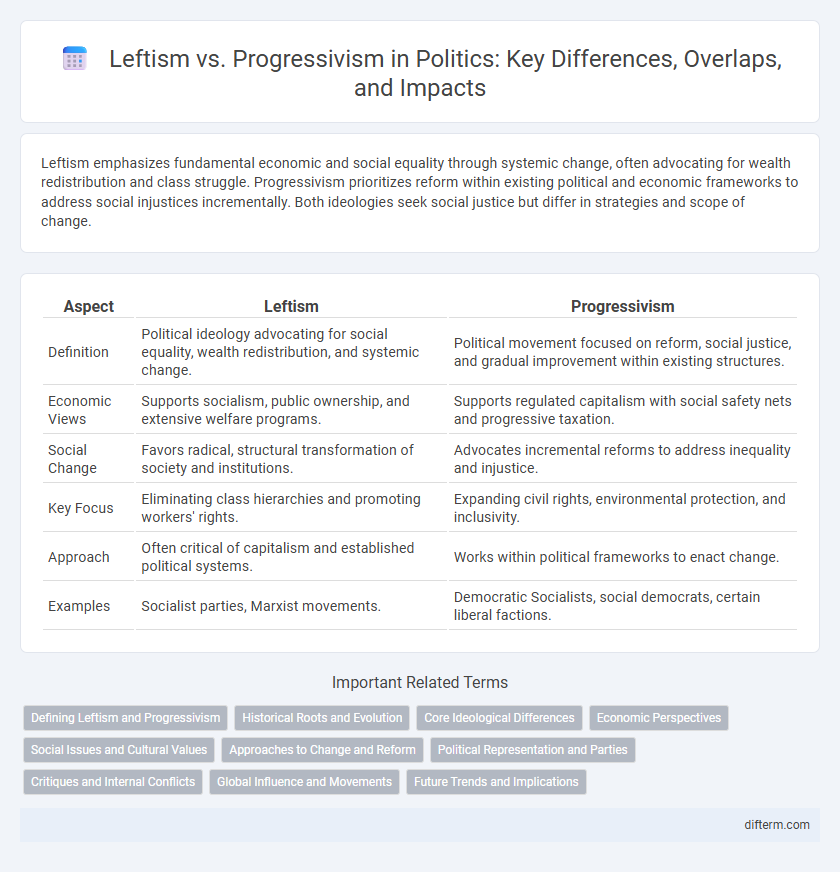Leftism emphasizes fundamental economic and social equality through systemic change, often advocating for wealth redistribution and class struggle. Progressivism prioritizes reform within existing political and economic frameworks to address social injustices incrementally. Both ideologies seek social justice but differ in strategies and scope of change.
Table of Comparison
| Aspect | Leftism | Progressivism |
|---|---|---|
| Definition | Political ideology advocating for social equality, wealth redistribution, and systemic change. | Political movement focused on reform, social justice, and gradual improvement within existing structures. |
| Economic Views | Supports socialism, public ownership, and extensive welfare programs. | Supports regulated capitalism with social safety nets and progressive taxation. |
| Social Change | Favors radical, structural transformation of society and institutions. | Advocates incremental reforms to address inequality and injustice. |
| Key Focus | Eliminating class hierarchies and promoting workers' rights. | Expanding civil rights, environmental protection, and inclusivity. |
| Approach | Often critical of capitalism and established political systems. | Works within political frameworks to enact change. |
| Examples | Socialist parties, Marxist movements. | Democratic Socialists, social democrats, certain liberal factions. |
Defining Leftism and Progressivism
Leftism centers on social equality and often advocates for systemic change through redistribution of wealth, emphasizing class struggle and anti-capitalist policies. Progressivism prioritizes reform within existing political frameworks, aiming to address social injustices and promote environmental sustainability through gradual legislative and social improvements. While both ideologies seek social justice, leftism typically calls for more radical transformations compared to the pragmatic and policy-driven approach of progressivism.
Historical Roots and Evolution
Leftism traces its origins to 18th-century revolutionary movements advocating for social equality and workers' rights, evolving through Marxist socialism and anarchism. Progressivism emerged in the late 19th and early 20th centuries within the United States, emphasizing government reform, social justice, and addressing industrialization's impacts. Both ideologies have continuously adapted, with leftism often focusing on systemic economic change while progressivism emphasizes pragmatic policy reforms and expanded civil rights.
Core Ideological Differences
Leftism emphasizes systemic change through redistributive policies and class struggle to achieve economic equality, often advocating for socialism or communism. Progressivism centers on reforming existing institutions to promote social justice, environmental sustainability, and expanded civil rights without necessarily rejecting capitalism. While both ideologies seek societal improvement, leftism demands fundamental structural overhaul, whereas progressivism supports incremental improvements within the current political framework.
Economic Perspectives
Leftism advocates for systemic economic overhaul through wealth redistribution, social ownership, and strong labor rights to reduce inequality and promote collective welfare. Progressivism emphasizes reforming capitalism with regulatory policies, social safety nets, and inclusive growth aimed at addressing economic disparities without dismantling market structures. Both ideologies prioritize economic justice but diverge in methods, with leftism favoring radical structural change and progressivism supporting pragmatic, incremental policy adjustments.
Social Issues and Cultural Values
Leftism emphasizes redistributive economic policies and systemic change to address social inequalities, often prioritizing class struggle and collective ownership. Progressivism focuses on reform-driven policies promoting social justice, inclusivity, and cultural pluralism, advocating incremental change within existing institutions. Both ideologies support LGBTQ+ rights and racial equality, but progressivism tends to balance economic reform with pragmatic solutions, whereas leftism pushes for more radical shifts in power dynamics.
Approaches to Change and Reform
Leftism emphasizes transformative change through systemic overhaul and often advocates for radical redistribution of power and resources to achieve social justice. Progressivism prioritizes incremental reforms within existing institutions, focusing on policy adjustments and pragmatic solutions to address inequality and promote social welfare. Both ideologies seek societal improvement but diverge in their strategies, with leftism favoring profound structural shifts and progressivism endorsing gradual evolution.
Political Representation and Parties
Leftism and progressivism often diverge in political representation, with leftist movements advocating for more radical systemic changes and prioritizing class struggle, while progressives emphasize incremental reforms within existing political frameworks. Political parties aligned with leftism, such as socialist and communist parties, typically push for wealth redistribution and public ownership, whereas progressive parties focus on social justice issues, environmental policies, and expanding civil rights. Both factions influence legislative agendas, but their approaches to political representation shape distinct party platforms and voter bases.
Critiques and Internal Conflicts
Leftism and progressivism face critiques regarding ideological purity and practical policy implementation, with leftism often criticized for radicalism and progressivism for incrementalism. Internal conflicts arise from debates over strategies, such as prioritizing systemic overhaul versus reform within existing institutions. These tensions impact coalition-building and influence political effectiveness in achieving social justice goals.
Global Influence and Movements
Leftism and progressivism shape global politics through diverse movements advocating social justice, economic equality, and environmental sustainability. Leftist ideologies often emphasize systemic change and wealth redistribution, influencing socialist and communist parties worldwide, while progressive movements prioritize reformist policies in democracies, impacting legislation on civil rights and climate action. Both ideologies drive significant mobilization, with international coalitions like the Progressive International and leftist groups fostering transnational solidarity and activism.
Future Trends and Implications
Leftism's emphasis on systemic change and wealth redistribution contrasts with progressivism's focus on social equity and incremental policy reforms. Future trends indicate that leftist movements may increasingly adopt digital activism and coalition-building to challenge economic inequalities, while progressives are likely to prioritize legislative advances on climate change and civil rights. The implications include potential shifts in party platforms and voter alignments as both ideologies respond to evolving social and economic challenges.
leftism vs progressivism Infographic

 difterm.com
difterm.com